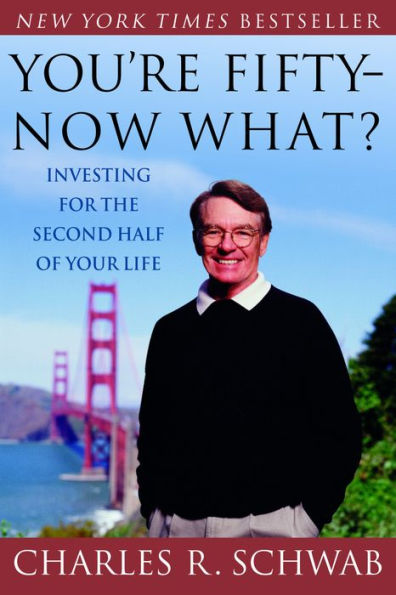You're Fifty -- Now What?: Investing for the Second Half of Your Life
Every eight seconds someone in this country turns 50, an age at which even baby boomers can no longer put off becoming fiscally responsible and planning for the future. For everyone who finds that thought daunting (and that's an awful lot of us), Charles R. Schwab, America's most trusted figure in financial services, is here to outline the simple steps we should take to evaluate what we have, determine what we'll need, and put our money to work to make our future one of reward instead of worry.
In the same upbeat, user-friendly style that made Charles Schwab's Guide to Financial Independence a bestseller, You're Fifty- Now What? offers a mix of clear and workable advice, simple worksheets, and a healthy dose of encouragement. In addition to learning how to accumulate and grow their money, readers will even find help with estate planning and charitable giving.
His message is that the goal is not just financial security, but financial peace of mind. The way to get there is not by being a spectator, but a participant. It doesn't take special talent or advanced degrees; it just takes attention and a little time. With baby-boomers living longer and spending more time in retirement, the need is clear. Charles Schwab's You're Fifty- Now What? is the perfect place to get started.
"1111611180"
In the same upbeat, user-friendly style that made Charles Schwab's Guide to Financial Independence a bestseller, You're Fifty- Now What? offers a mix of clear and workable advice, simple worksheets, and a healthy dose of encouragement. In addition to learning how to accumulate and grow their money, readers will even find help with estate planning and charitable giving.
His message is that the goal is not just financial security, but financial peace of mind. The way to get there is not by being a spectator, but a participant. It doesn't take special talent or advanced degrees; it just takes attention and a little time. With baby-boomers living longer and spending more time in retirement, the need is clear. Charles Schwab's You're Fifty- Now What? is the perfect place to get started.
You're Fifty -- Now What?: Investing for the Second Half of Your Life
Every eight seconds someone in this country turns 50, an age at which even baby boomers can no longer put off becoming fiscally responsible and planning for the future. For everyone who finds that thought daunting (and that's an awful lot of us), Charles R. Schwab, America's most trusted figure in financial services, is here to outline the simple steps we should take to evaluate what we have, determine what we'll need, and put our money to work to make our future one of reward instead of worry.
In the same upbeat, user-friendly style that made Charles Schwab's Guide to Financial Independence a bestseller, You're Fifty- Now What? offers a mix of clear and workable advice, simple worksheets, and a healthy dose of encouragement. In addition to learning how to accumulate and grow their money, readers will even find help with estate planning and charitable giving.
His message is that the goal is not just financial security, but financial peace of mind. The way to get there is not by being a spectator, but a participant. It doesn't take special talent or advanced degrees; it just takes attention and a little time. With baby-boomers living longer and spending more time in retirement, the need is clear. Charles Schwab's You're Fifty- Now What? is the perfect place to get started.
In the same upbeat, user-friendly style that made Charles Schwab's Guide to Financial Independence a bestseller, You're Fifty- Now What? offers a mix of clear and workable advice, simple worksheets, and a healthy dose of encouragement. In addition to learning how to accumulate and grow their money, readers will even find help with estate planning and charitable giving.
His message is that the goal is not just financial security, but financial peace of mind. The way to get there is not by being a spectator, but a participant. It doesn't take special talent or advanced degrees; it just takes attention and a little time. With baby-boomers living longer and spending more time in retirement, the need is clear. Charles Schwab's You're Fifty- Now What? is the perfect place to get started.
14.99
In Stock
5
1

You're Fifty -- Now What?: Investing for the Second Half of Your Life
336
You're Fifty -- Now What?: Investing for the Second Half of Your Life
336Related collections and offers
14.99
In Stock

Product Details
| ISBN-13: | 9780609504222 |
|---|---|
| Publisher: | Crown Publishing Group |
| Publication date: | 03/01/2001 |
| Sold by: | Random House |
| Format: | eBook |
| Pages: | 336 |
| File size: | 2 MB |
About the Author
From the B&N Reads Blog
